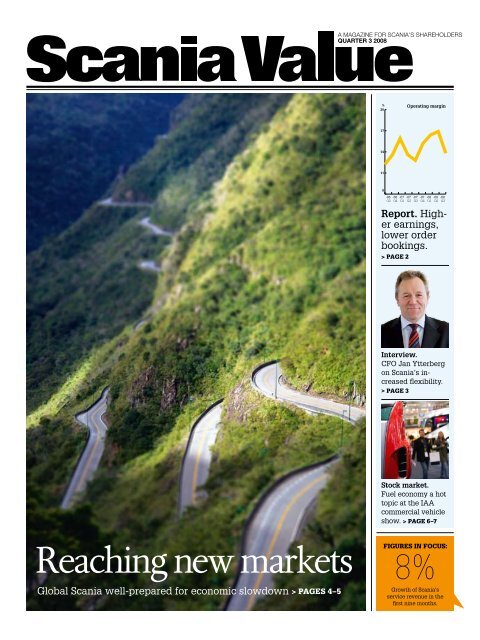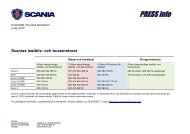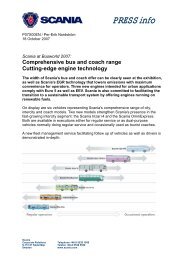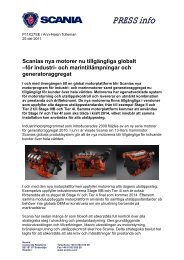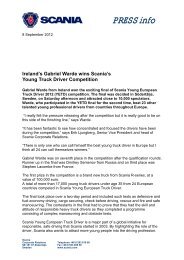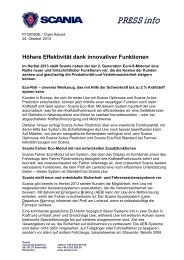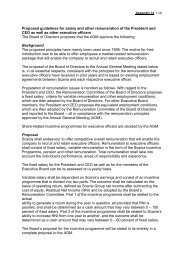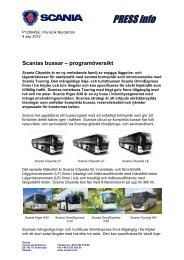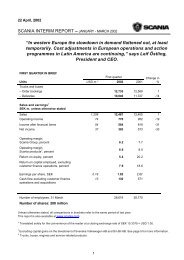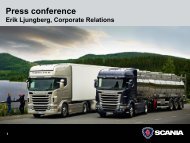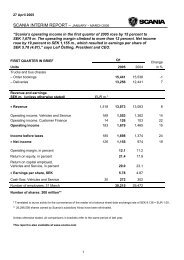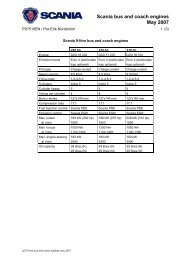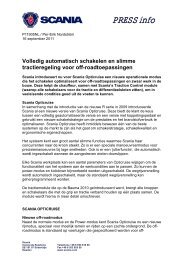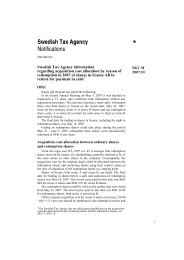Download Scania Value
Download Scania Value
Download Scania Value
You also want an ePaper? Increase the reach of your titles
YUMPU automatically turns print PDFs into web optimized ePapers that Google loves.
A MAGAZINE FOR SCANIA'S SHAREHOLDERS<br />
QUARTER 3 2008<br />
%<br />
20<br />
Operating margin<br />
17<br />
14<br />
11<br />
8<br />
-06 -06 -07 -07 -07 -07 -08 -08 -08<br />
Q3 Q4 Q1 Q2 Q3 Q4 Q1 Q2 Q3<br />
Report. Higher<br />
earnings,<br />
lower order<br />
bookings.<br />
> PAGE 2<br />
Interview.<br />
CFO Jan Ytterberg<br />
on <strong>Scania</strong>’s increased<br />
flexibility.<br />
> PAGE 3<br />
Stock market.<br />
Fuel economy a hot<br />
topic at the IAA<br />
commercial vehicle<br />
show. > PAGE 6–7<br />
Reaching new markets<br />
Global <strong>Scania</strong> well-prepared for economic slowdown > PAGES 4–5<br />
FIGURES IN FOCUS:<br />
8%<br />
Growth of <strong>Scania</strong>’s<br />
service revenue in the<br />
first nine months.
FIRST nine months IN FIGURES<br />
Order bookings and deliveries by region, 9 months (number of vehicles)<br />
western europe<br />
Order bookings<br />
19,153 -49%<br />
Deliveries<br />
27,540 +4%<br />
central and<br />
eastern europe<br />
Order bookings<br />
8,413 -33%<br />
Deliveries<br />
10,899 -2%<br />
LATIN AMERICA<br />
Order bookings<br />
11,378 +19%<br />
Deliveries<br />
9,097 +5%<br />
other markets<br />
Order bookings<br />
3,238 +43%<br />
Deliveries<br />
2,219 -11%<br />
ASIA<br />
Order bookings<br />
6,429 +6%<br />
Deliveries<br />
6,063 +15%<br />
Net sales<br />
Net sales by product segment, 9 m<br />
Operating income and margin<br />
SEK m.<br />
25,000<br />
20,000<br />
Used vehicles 5.1%<br />
Other 4.2%<br />
%<br />
20<br />
16<br />
Operating income, SEK m.<br />
Operating margin, percent<br />
SEK m.<br />
5,000<br />
4,000<br />
15,000<br />
Services 18.2%<br />
12<br />
3,000<br />
10,000<br />
5,000<br />
Key figures<br />
0<br />
2006 Q3<br />
2006 Q4<br />
2007 Q1<br />
2007 Q2<br />
2007 Q3<br />
2007 Q4<br />
2008 Q1<br />
2008 Q2<br />
2008 Q3<br />
Engines 1.3%<br />
Buses and<br />
coaches 8.7%<br />
Trucks 62.5%<br />
(SEK unless otherwise noted) 2008, 9 m 2007, 9 m Change in, %<br />
Net sales, <strong>Scania</strong> Group 66,319 59,947 11<br />
Operating income, Vehicles and Services 10,089 8,064 25<br />
Operating income, Financial Services 366 378 -3<br />
Operating income 10,455 8,442 24<br />
Net income before taxes 10,270 8,265 24<br />
Net income for the period 7,369 5,847 26<br />
Operating margin, percent 15.8 14.1 -<br />
Net margin, percent 11.1 9.8 -<br />
Return on equity, percent 43.3 31.4 -<br />
Return on capital employed,<br />
Vehicles and Services, percent<br />
50.5 37.3<br />
-<br />
Earnings per share, SEK 9.21 7.31 -<br />
Cash flow, Vehicles and Services 3,638 4,240 -<br />
Number of employees, 30 september 36,226 34,650 -<br />
Order bookings (Units, trucks and bus chassis) 48,611 68,086 -29<br />
Deliveries (Units, trucks and bus chassis) 55,818 53,873 4<br />
8<br />
4<br />
0<br />
2006 Q3<br />
2006 Q4<br />
2007 Q1<br />
2007 Q2<br />
2007 Q3<br />
2007 Q4<br />
2008 Q1<br />
2008 Q2<br />
2008 Q3<br />
2,000<br />
1,000<br />
Q3 IN SHORT:<br />
Operating margin<br />
rose to 15.8% in the first<br />
nine months and to 13.8%<br />
in the third quarter.<br />
Deliveries increased by<br />
4% to 55,818 vehicles in the<br />
first nine months and were<br />
unchanged in the third<br />
quarter.<br />
Order bookings<br />
declined by 29% in the first<br />
nine months and by 38% in<br />
the third quarter.<br />
0<br />
2 SCANIA VALUE • Q3/2008 www.scania.com
t e x t: p e t r a l o d é n p h o t o:d a n b o m a n<br />
INTERVIEW<br />
“This gives us a<br />
more flexible<br />
cost structure”<br />
<strong>Scania</strong> has gradually become better at<br />
handling fluctuations in demand, says CFO<br />
Jan Ytterberg.<br />
Good timing for global production<br />
A global product range, increased<br />
outsourcing and continuous<br />
improvements have together<br />
resulted in a significantly more<br />
flexible, efficient <strong>Scania</strong>. But due<br />
to weaker economic conditions,<br />
especially in Europe, <strong>Scania</strong> now<br />
has to tighten up its operations.<br />
“We still have an order backlog that we are working<br />
our way through, but the number of orders is<br />
indeed declining now. There is overcapacity in the<br />
transport industry and it is difficult to get a good<br />
grasp of the underlying demand for new vehicles<br />
during the prevailing financial market turbulence,<br />
with the consequent difficulty for our customers<br />
to obtain financing. Making ten-year forecasts is<br />
easy. It is harder to say how things will be going<br />
one or two years from now,” says Jan Ytterberg,<br />
<strong>Scania</strong>’s Chief Financial Officer (CFO).<br />
The economic slowdown following the home<br />
mortgage and financial crisis will not leave <strong>Scania</strong><br />
untouched. But the company has gradually<br />
become better equipped to cope with fluctuations<br />
in demand. The latest example is <strong>Scania</strong>’s<br />
global production programme, which means that<br />
the same truck series are being manufactured<br />
in Europe and Latin America. The advantages<br />
become clear when order bookings weaken in<br />
the European market and <strong>Scania</strong> meanwhile sees<br />
strong demand in South America and Asia.<br />
“It was good timing that the global production<br />
programme became a reality right now. We can shift<br />
production from Latin America to Europe in order<br />
to achieve more balanced capacity utilisation.”<br />
Another way of dealing with fluctuations in<br />
demand is to ensure that the company has the<br />
right staffing for every situation. <strong>Scania</strong> has a<br />
flexible system for its production employees; a<br />
“time bank” that serves as an initial regulator in<br />
various cyclical situations. Put simply, the system<br />
operates like a bank account. Time can be deposited<br />
in the bank and withdrawn according to<br />
production needs. The company also uses staffing<br />
companies as well as temporary contracts. Not<br />
renewing temporary contracts is another way of<br />
adjusting production to lower demand.<br />
<strong>Scania</strong> focuses on making strategic components,<br />
especially those related to fuel consumption, such<br />
as engines, gearboxes and axles. Everything else<br />
that is not regarded as strategic can be outsourced.<br />
In this way, <strong>Scania</strong> keeps its own value-added<br />
down. Of all the components that a truck chassis<br />
consists of, in-house production today accounts<br />
for only 30 per cent of the cost. This figure was previously<br />
40 per cent. If superstructures are included,<br />
<strong>Scania</strong>’s own value-added is substantially lower.<br />
“This gives us a more flexible cost structure. But<br />
we are continuously re-assessing our cost structure,<br />
and now that we are entering an economic<br />
slowdown, we have to tighten up our operations.”<br />
This means that, starting in November, <strong>Scania</strong><br />
will be adjusting its production rate.<br />
“<strong>Scania</strong>’s cash flow has been strong over a long<br />
period. This is partly due to good sales and partly<br />
because we have focused on not tying up capital<br />
unnecessarily − in trade receivables or inventories.<br />
When demand weakens, it becomes even<br />
more important to focus on cash flow. If truck<br />
sales decrease rapidly, we build up inventories<br />
and then we have to act and lower our production<br />
rate,” Mr Ytterberg says.<br />
<strong>Scania</strong>’s cash flow is a prerequisite for being<br />
able to act independently in a period of credit<br />
market turbulence.<br />
<strong>Scania</strong> was trimming its production even<br />
during the boom period. One example is the<br />
transfer of gearbox and axle production to<br />
Södertälje, at the same time as certain non-strategic<br />
parts were outsourced to sub-contractors.<br />
Meanwhile <strong>Scania</strong> concentrated its European<br />
parts warehouse operations in Opglabbeek, Belgium.<br />
Altogether, these measures will provide<br />
annual savings of SEK 300 m. per year, with full<br />
effect starting in 2009.<br />
www.scania.com<br />
Q3/2008 • SCANIA VALUE 3
<strong>Scania</strong> sees opportunities in the growth of emerging markets.<br />
New markets help in eco<br />
FOCUS: BUSINESS CYCLE<br />
p h o t o: m2 p h o t o s t u d i o<br />
In response to the financial crisis<br />
and the economic slowdown, truck<br />
customers in Europe are now<br />
applying the brakes after several<br />
years of strong demand. But<br />
<strong>Scania</strong> today is a global company<br />
that has the potential to benefit<br />
from growth in new markets.<br />
The financial market crisis has become deeper<br />
than most observers had expected and has rapidly<br />
led to repercussions in the real economy.<br />
The main impact on <strong>Scania</strong> is in Europe, which<br />
only a few quarters ago was roaring ahead.<br />
Martin Lundstedt, head of Franchise and Factory<br />
Sales, explains that Europe is now moving<br />
from historically exceptional demand levels to a<br />
“wait-and-see attitude.”<br />
“Europe has been an enormously strong market,<br />
where our customers have been upgrading<br />
their truck fleets as a consequence of new emission<br />
requirements, among other things. Now<br />
they have decided to wait for a few quarters.”<br />
Although no part of the world appears likely<br />
to entirely avoid the shock waves from the<br />
US financial crisis, there is good potential for<br />
continued economic expansion in emerging<br />
economies. In <strong>Scania</strong>’s assessment, the role of<br />
Europe, expressed as as a percentage of total<br />
Group sales, will decrease.<br />
“The old markets are now weakening, but our<br />
new markets are meanwhile becoming important<br />
and we are increasing our deliveries to them. We<br />
have a common global production platform that<br />
is unique in the industry,” Mr Lundstedt says.<br />
In many countries that previously had hardly<br />
any middle class, increased prosperity is evident<br />
and there is major spending on infrastructure. A<br />
consequence of this is a growing need for transport<br />
services.<br />
One example is Russia, where <strong>Scania</strong>’s sales<br />
volume has doubled in the past five years. Today,<br />
Russia is <strong>Scania</strong>’s fifth largest market. Despite<br />
recent turbulence in Russia, which will affect<br />
demand in a short-term perspective, there will be<br />
large remaining long-term needs for transport in<br />
many areas: these include the commodity sector,<br />
infrastructure investments and the residential<br />
sector, which is driven by greater prosperity.<br />
“In many of the former Soviet states, a transition<br />
is also under way from local truck makes to<br />
western European ones. <strong>Scania</strong> also has an optimal<br />
service network in Russia, which gives us an<br />
advantage,” Mr Lundstedt says.<br />
In Latin America − including Brazil, <strong>Scania</strong>’s<br />
largest single market − growth has been high in<br />
sectors important to <strong>Scania</strong>, such as mining and<br />
agriculture.<br />
“Mining, forestry, oil and agriculture – many<br />
sectors have set new records,” he says.<br />
Many of the countries where <strong>Scania</strong> is now<br />
growing have been characterised by political<br />
instability and sharp economic fluctuations.<br />
In recent years, Latin America in particular has<br />
stabilised. Today <strong>Scania</strong>, is also better at quickly<br />
adapting its operations to turbulent markets.<br />
“Our flexible production system, short lead<br />
4 SCANIA VALUE • Q3/2008 www.scania.com
t e x t: p e t r a l o d é n<br />
Higher GDP driver of truck sales<br />
p h o t o: n o r d e a<br />
New truck sales (above 16 tonnes) per million inhabitants<br />
DK<br />
p h o t o: r e n a t o m e r l i n i<br />
1,000<br />
AT<br />
NO<br />
BE<br />
CZ<br />
DE<br />
SK<br />
NL<br />
800<br />
ES<br />
IE<br />
BY<br />
RU<br />
FR<br />
600<br />
SE<br />
PL<br />
FI<br />
RO HU<br />
IT<br />
UK<br />
400<br />
PT<br />
BG<br />
HR<br />
200<br />
UA<br />
GDP<br />
USD/Capita<br />
0<br />
0 10,000 20,000 30,000 40,000 50,000 60,000 70,000 80,000 90,000<br />
Th e r e is a clear connection between general economic development and truck sales. Denmark had<br />
the highest sales per capita in 2007, Ukraine had the lowest sales.<br />
p h o t o: h e n r i q u e l o r c a<br />
p h o t o: c a r l-e r i k a n d e r s s o n<br />
Annika<br />
Winsth,<br />
Nordea<br />
Will emerging countries<br />
set off on their<br />
own path now?<br />
Despite their slowdown, the BRIC<br />
countries will show good growth<br />
even over the next few years, according<br />
to forecasts from Nordea,<br />
a major Scandinavian bank. But<br />
the US still dominates the world<br />
economy, explains Annika Winsth,<br />
chief analyst at Nordea in Sweden.<br />
nomic slump<br />
times and well-developed logistics enable us not<br />
only to cope with economic fluctuations well, but<br />
also countries that are volatile as such. You have<br />
to be close to the market. The challenge lies in<br />
using the flexibility we have built into the organisation<br />
and adapting ourselves to changes,” Mr<br />
Lundstedt says.<br />
“We have a global<br />
production platform<br />
that is unique in the<br />
industry”<br />
<strong>Scania</strong>’s global reach, however, extends further<br />
than Russia and Brazil. Another market with<br />
growth potential is the Middle East.<br />
“The Middle East is continuing its strong<br />
growth. There is a lot of construction, and the<br />
oil industry generates major transport needs.<br />
In those countries suffering from great political<br />
unrest, we expect stabilisation to emerge eventually.<br />
In Iraq around 4,000 <strong>Scania</strong> trucks are on<br />
the roads and <strong>Scania</strong> is a strong brand.”<br />
ASIA, Of course, and perhaps India above all,<br />
is another market where major opportunities are<br />
opening up for <strong>Scania</strong>. The company is focusing<br />
on markets and segments where it is possible to<br />
achieve sustained, profitable growth.<br />
“The mining industry in India is a good<br />
example of a niche segment requiring special<br />
sol utions that <strong>Scania</strong> is good at.”<br />
Asia is also perhaps the best example of<br />
demographic changes that will benefit <strong>Scania</strong> in a<br />
somewhat longer perspective:<br />
“Due to increased urbanisation, 50 per cent of<br />
the world’s population today lives in cities, and<br />
this percentage continuing to rise. This means<br />
there is great demand for transporting goods,<br />
food and so on. More buses are also needed to<br />
provide public transport in cities,” Mr Lundstedt<br />
says.<br />
t h e incredible g r o w t h over recent years in<br />
the BRIC countries (Brazil, Russia, India, China)<br />
has generated hopes that the world economy<br />
will no longer be so dependent on the United<br />
States. But Annika Winsth believes that even<br />
in the future, we will have to live with the fact<br />
that economic developments in the US will have<br />
direct consequences in the rest of the world.<br />
“The US is such a large economy that it doesn’t<br />
help that emerging economies are performing<br />
well – the economic situation in the world will<br />
continue to be strongly dependent on the US.”<br />
However, even if no one seems able to completely<br />
escape the consequences of the financial<br />
meltdown on Wall Street, there are likely to be<br />
continued major differences in growth rates<br />
between the western world and the BRIC countries.<br />
According to Nordea’s forecast, the US and<br />
the euro zone will have to be content with less<br />
than one percent growth in 2009.<br />
“In Russia, we anticipate annual growth of<br />
between 6 and 7 percent during the next few<br />
years. Russia has been driven for some time by<br />
high oil prices and has seen an enormous influx<br />
of capital. But there is political uncertainty in<br />
Russia, and companies are wondering whether<br />
they can really trust the country’s leaders.”<br />
Brazil has also experienced strong growth,<br />
benefiting from strong domestic demand.<br />
“We are forecasting 3.3 per cent growth in<br />
2009, mainly driven by investments and good<br />
private consumption demand.”<br />
The trend is the same in China and India. Although<br />
these economies will expand at a slower<br />
pace, India is expected to grow by 6.5 percent<br />
in 2009 and China by 9 percent.<br />
www.scania.com<br />
Q3/2008 • SCANIA VALUE 5
STOCK MARKET<br />
All the leading truck manufacturers were present at the Hanover fair.<br />
Fuel economy takes<br />
center stage at truck show<br />
Due to continued high fuel costs,<br />
a weaker economy and greater<br />
focus on environmental issues,<br />
this year’s IAA commercial vehicle<br />
show devoted a great deal of<br />
attention to fuel economy and the<br />
environment.<br />
During the past year alone, the price of diesel<br />
has climbed 30 percent. Factor in the growing<br />
environmental demands on the transport industry<br />
and an international economic slowdown,<br />
and it is easy to understand why good fuel economy<br />
was among the most important themes of the<br />
IAA commercial vehicle show in Hanover, Germany,<br />
this past September.<br />
“For many customers, fuel accounts for<br />
be tween 25 and 35 percent of their total cost. It can<br />
mean the difference between a positive or negative<br />
bottom line,” said Martin Lundstedt, Head of<br />
Franchise and Factory Sales, during the IAA show.<br />
Viewed over the past five years, the price of<br />
diesel has roughly doubled (measured in the Swedish<br />
market). <strong>Scania</strong>’s message was also clear: <strong>Scania</strong><br />
will continue to be a leader in the commercial<br />
vehicle industry when it comes to fuel efficiency.<br />
But this is not just a matter of fuel-efficient engines.<br />
“Our leading position is based on three cornerstones:<br />
the vehicle, the driver and service to<br />
our customers,” said Henrik Henriksson, head of<br />
<strong>Scania</strong> Trucks at Franchise and Factory Sales.<br />
Engine performance is obviously of central<br />
importance to a vehicle, along with such factors<br />
as aerodynamics, low rolling resistance and good<br />
cargo capacity. The role of drivers is also crucial.<br />
“<strong>Scania</strong> driver training can help even experienced<br />
drivers improve their fuel economy by<br />
around 10 percent,” Mr Henriksson explained,<br />
also emphasising that regular service provides a<br />
basis for additional savings.<br />
This is where large improvements are achieved<br />
by small means. Taking five minutes to check<br />
<strong>Scania</strong> will reduce its<br />
CO2 emissions by 50%,<br />
said Martin Lundstedt.<br />
air pressure and<br />
adjust wheel axles<br />
may result in noticeably<br />
lower fuel<br />
consumption.<br />
“Conservatively<br />
speaking, if we include<br />
every factor − vehicle,<br />
driver and service −<br />
we can save at least 10<br />
per cent of fuel. This<br />
also reduces carbon<br />
dioxide emissions.”<br />
As for service, <strong>Scania</strong><br />
invests around SEK 1 billion a year to expand<br />
its network of workshops and broaden their<br />
range of services, in order to move even closer to<br />
its customers.<br />
<strong>Scania</strong> was not alone at the IAA show in talking<br />
about fuel economy. All leading truck manufacturers<br />
devoted extensive space to this theme.<br />
6 SCANIA VALUE • Q3/2008 www.scania.com
t e x t: g ö r a n l i n d f o t o: d a n b o m a n<br />
Fuel almost 30% of the total cost<br />
Salaries 33%<br />
Fuel 27%<br />
Other 7%<br />
Tyres 3%<br />
Administration 7%<br />
Repair and<br />
maintenance 9%<br />
Vehicles 14%<br />
Leif Östling, CEO <strong>Scania</strong>, visited Hanover, where the business cycle and fuel prices were in focus.<br />
f u e l is a major cost item. For a long-haulage<br />
operator fuel, is almost 30 percent of<br />
the total cost.<br />
“The show was dominated by two issues: One<br />
was the economic situation, with many people<br />
being clearly more pessimistic about business<br />
trends, especially in Europe. The other was the<br />
fuel issue, viewed both from an economic and<br />
an environmental standpoint,” says Christer Fredriksson,<br />
an analyst at ABG Sundal Collier.<br />
Mr Fredriksson regards the focus on the fuel<br />
issue as entirely justified, since fuel has played<br />
and will continue to play a major role in the future<br />
competitiveness of the trucking industry.<br />
“<strong>Scania</strong> is in the forefront of development<br />
work, but the competition is tough. It is also my<br />
feeling today that economics is priority number<br />
one. In the current situation you cannot ignore<br />
the economic benefits that you can derive from<br />
being environmentally friendly.”<br />
Arne C. Karlsson, an analyst at the Alecta pension<br />
insurance company, concurs that <strong>Scania</strong> has<br />
carved out a prominent position in the development<br />
of fuel-efficient, environmentally friendly<br />
vehicles.<br />
“<strong>Scania</strong> always enjoys great trust, as a rule,<br />
<strong>Scania</strong> doesn’t fall behind in engine development<br />
either. I think that even today, the company is up<br />
to speed as much as it needs to be. At the same<br />
time, quite a lot of companies claim to be ahead in<br />
development terms. I think it is hard to differentiate<br />
yourself against the competition,” Mr Karlsson says.<br />
Lower fuel consumption not only leads to<br />
lower costs, but also means lower carbon dioxide<br />
emissions. This is why the environmental issue<br />
and fuel economy go hand in hand.<br />
One clear example of this is <strong>Scania</strong>’s hybrid<br />
technology, in which energy that arises when<br />
the driver applies the brake is stored and reused.<br />
Starting this autumn, <strong>Scania</strong>’s ethanol-powered<br />
hybrid buses are being field-tested in Stockholm.<br />
“Ethanol-powered hybrids yield a double<br />
effect: 25 percent better fuel economy and 90<br />
percent lower carbon dioxide emissions, since<br />
the buses are powered by a renewable fuel,”<br />
says Melker Jernberg, head of <strong>Scania</strong> Buses and<br />
Coaches at Franchise and Factory Sales.<br />
Another example is driver training, which can<br />
not only reduce fuel consumption, but is also<br />
the single most important way to reduce carbon<br />
dioxide emissions.<br />
“We have said that we will reduce carbon<br />
dioxide emissions by 50 percent per transported<br />
tonne-kilometre between 2000 and 2020. I<br />
believe this is a fully realisable target. It will be<br />
achieved through a combination of fuel-efficient<br />
driving, technological development, biofuels<br />
and legislation,” Mr Lundstedt said.<br />
Share price, <strong>Scania</strong> B, 1 October 2006 – 22 October 2008<br />
200<br />
200<br />
150<br />
150<br />
100<br />
100<br />
50 50<br />
2006/10/01<br />
<strong>Scania</strong> B<br />
OMX Stockholm<br />
SX Industrial<br />
2007/10/01<br />
2008/10/01<br />
s o u r c e : n a s d a q o m x<br />
FINANCIAL CRISIS<br />
HITS SHARE PRICE<br />
The <strong>Scania</strong> share price fell 24 percent<br />
from 1 July to 22 October, in<br />
line with the general decline on the<br />
Stockholm Stock Exchange (OMX<br />
Stockholm All Share Index). The<br />
financial turbulence together with<br />
fears of a deeper and longer recession<br />
than expected were the main<br />
reasons behind the decline.<br />
0<br />
www.scania.com<br />
Q3/2008 • SCANIA VALUE 7
NOTES<br />
<strong>Scania</strong>’s clothing<br />
collection a hit<br />
Hello, Sophie Haftor<br />
Helmersson,<br />
brand manager<br />
of <strong>Scania</strong>’s own<br />
clothing collection<br />
− <strong>Scania</strong> Truck<br />
Gear, which offers<br />
everything from<br />
outer garments,<br />
jeans, shirts and<br />
sweaters to boots<br />
and sunglasses.<br />
Sophie Haftor Helmersson,<br />
responsible for the<br />
How are sales going? <strong>Scania</strong> clothes collection.<br />
“There has been a<br />
fantastic level of interest since we started in 2006.<br />
One important reason why the clothes have been such<br />
a great success is that they reflect the company’s core<br />
values and design. They are perceived as robust, highquality<br />
items.”<br />
Are truck drivers the only ones who buy these clothes?<br />
“No. Naturally, a large proportion of customers<br />
drive <strong>Scania</strong> trucks. But interest in the clothes quickly<br />
spread to spouses and other family members. Today,<br />
people who have no direct connection to the trucking<br />
industry or to <strong>Scania</strong> are also buying our clothes. In<br />
addition to functional garments that are specially<br />
targeted at professional drivers, we also have an ‘off<br />
road’ collection that anyone can use. Initially, this was<br />
only for men, but last year we also introduced a collection<br />
for women.”<br />
Where can you buy these clothes?<br />
“You can buy them on the web and at <strong>Scania</strong> dealerships<br />
in Europe and Asia. We will also be launching<br />
our clothes in Latin America. We also sell a lot of them<br />
at various events, such as truck shows and the like.”<br />
What sells the best?<br />
“The leather belt with the <strong>Scania</strong> grille in brushed<br />
steel on the buckle is probably our best-selling item. Our<br />
sunglasses (with the <strong>Scania</strong> logo) also sell very well.”<br />
Do you have any personal favourite?<br />
“What I like best myself is probably the soft shell<br />
jacket, which can be used for most leisure activities<br />
and is a perfect autumn and spring garment.”<br />
Trucks for Brazil<br />
s c a n i a is d e l i v e r i n g 260 tipper trucks to<br />
the Brazilian company Odebrecht. The delivery<br />
includes driver training and on-board<br />
transport planning computers. It is the largest<br />
single truck order in the 51-year history<br />
of <strong>Scania</strong> Brasil.<br />
“This is a very important transaction, not<br />
only because it includes many trucks but<br />
because it also confirms and strengthens<br />
<strong>Scania</strong>’s position in the construction segment.<br />
According to Odebrecht, our trucks meet all<br />
their requirements and provide the best overall<br />
operating economy,” says Robert Leoncini,<br />
<strong>Scania</strong> Brasil’s sales manager.<br />
All the vehicles are <strong>Scania</strong> P 420 model threeaxle<br />
trucks with 420 hp engines. All trucks will<br />
be supplied with on-board computers for realtime<br />
vehicle monitoring and transport planning.<br />
Singapore to get 400 new city buses<br />
s b s t r a n s i t, Singapore’s leading public<br />
transport company, has ordered 400 <strong>Scania</strong><br />
buses in addition to the 500 units ordered in<br />
2007. With engines featuring EGR technology,<br />
these buses will meet both 2009 European<br />
emission standards (Euro 5) and the<br />
stricter enhanced environmentally friendly<br />
vehicle (EEV) standard. The order is part of<br />
SBS Transit’s on-going replacement of its<br />
fleet of 2,800 buses with vehicles featuring<br />
better environmental performance.<br />
“This additional order is evidence that SBS<br />
Transit has confidence in <strong>Scania</strong>. It is not just<br />
a matter of the passenger comfort, quality,<br />
environmental performance and operating<br />
UPCOMING<br />
FINANCIAL<br />
EVENTS<br />
2009<br />
2009-02-03<br />
Year-end report, 2008<br />
<strong>Scania</strong>’s trucks provide Odebrecht with the<br />
best total economy.<br />
100 of the trucks will be equipped with<br />
the computer-aided <strong>Scania</strong> Opticruise<br />
gearchanging system. Odebrecht’s choice of<br />
<strong>Scania</strong> Opticruise is based on the company’s<br />
own tests, which confirmed the benefits<br />
of the system in terms of driveability and<br />
efficiency.<br />
economy of<br />
these buses.<br />
Also decisive<br />
has been<br />
<strong>Scania</strong>’s ability<br />
to live up to the<br />
demand for<br />
a long-term<br />
partner that<br />
High environmental performance<br />
is one of the<br />
can adapt its<br />
products and<br />
reasons why Singapore<br />
services to the<br />
chose <strong>Scania</strong>.<br />
needs of SBS<br />
Transit,” says Norman Koh, General Manager<br />
of <strong>Scania</strong> Singapore.<br />
<strong>Scania</strong> <strong>Value</strong> is published by <strong>Scania</strong> and<br />
distributed to <strong>Scania</strong> shareholders.<br />
Publisher and Editor-in-chief<br />
Stina Thorman<br />
ir@scania.com<br />
Project Manager<br />
goran.lind@appelberg.com<br />
Art Director<br />
anders.ortegren@appelberg.com<br />
Production<br />
Appelberg Publishing<br />
www.appelberg.com<br />
Printing: Trosa Tryckeri<br />
Cover photo: M2 Photostudio<br />
2009-05-07<br />
Annual General Meeting<br />
Address<br />
<strong>Scania</strong><br />
Investor Relations<br />
SE-151 87 Södertälje<br />
Tel: +46 8 553 81 000<br />
<strong>Scania</strong>’s clothes are like the trucks: tough, highquality<br />
and well designed.<br />
8 SCANIA VALUE • Q3/2008 www.scania.com


